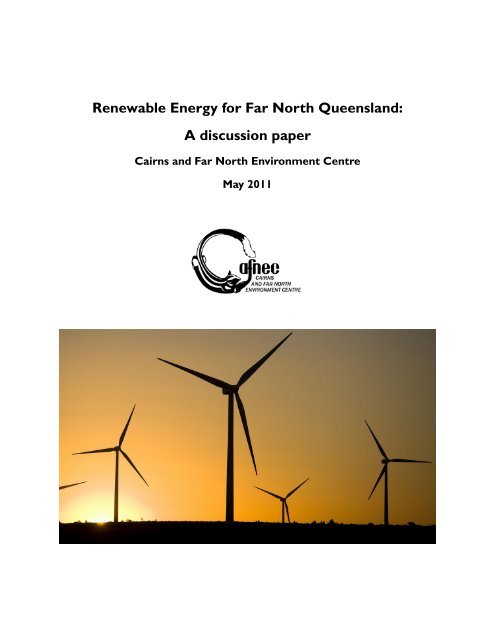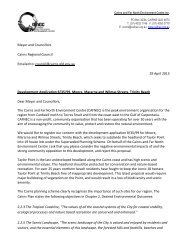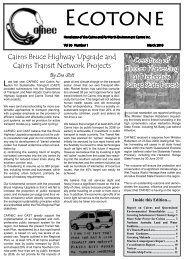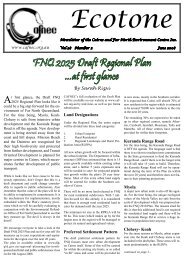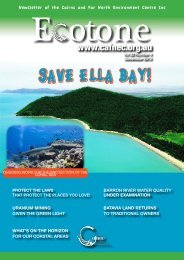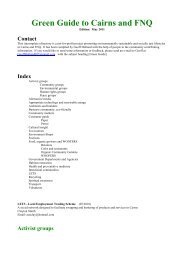Renewable Energy for Far North Queensland: A ... - CAFNEC
Renewable Energy for Far North Queensland: A ... - CAFNEC
Renewable Energy for Far North Queensland: A ... - CAFNEC
You also want an ePaper? Increase the reach of your titles
YUMPU automatically turns print PDFs into web optimized ePapers that Google loves.
<strong>Renewable</strong> <strong>Energy</strong> <strong>for</strong> <strong>Far</strong> <strong>North</strong> <strong>Queensland</strong>:<br />
A discussion paper<br />
Cairns and <strong>Far</strong> <strong>North</strong> Environment Centre<br />
May 2011
This document was prepared by Sophie<br />
Allen <strong>for</strong> the Cairns and <strong>Far</strong> <strong>North</strong><br />
Environment Centre.<br />
This document should be cited as:<br />
Cairns and <strong>Far</strong> <strong>North</strong> Environment Centre<br />
(<strong>CAFNEC</strong>) (2011) <strong>Renewable</strong> <strong>Energy</strong> <strong>for</strong><br />
<strong>Far</strong> <strong>North</strong> <strong>Queensland</strong>: A Discussion Paper,<br />
May 2011 (Ed. Sophie Allen), Cairns, (13pp).<br />
This document is copyright. The Copyright<br />
Act 1968 permits fair dealing <strong>for</strong> study,<br />
research, in<strong>for</strong>mation or educational<br />
purposes subject to inclusion of a sufficient<br />
acknowledgement of the source.
Cairns and <strong>Far</strong> <strong>North</strong> Environment Centre May 2011<br />
<strong>Renewable</strong> <strong>Energy</strong> <strong>for</strong> <strong>Far</strong> <strong>North</strong> <strong>Queensland</strong>: a discussion paper<br />
Executive Summary<br />
This discussion paper has been produced to initiate a dialogue regarding a renewable energy<br />
future <strong>for</strong> <strong>Far</strong> <strong>North</strong> <strong>Queensland</strong> (FNQ). It aims to in<strong>for</strong>m the community and key stakeholders<br />
about the options available <strong>for</strong> making this transition to renewable energy, and to lay the<br />
foundations <strong>for</strong> a more detailed report on how to progress towards a region powered by 100%<br />
renewable energy.<br />
The FNQ region is particularly suited to the production of renewable energy due to the<br />
abundance of high quality wind and solar energy resources. This region already produces up to<br />
a maximum of around 40% of its power from existing renewable energy projects including wind,<br />
hydro, solar and the waste product (bagasse) from sugar cane production.<br />
Globally, the level of investment in solar and wind energy projects is increasing and there is a<br />
rapid rate of development in renewable energy technologies and products. At the same time<br />
there is a growing understanding of the need <strong>for</strong> increased efficiency in generation and<br />
transmission, and <strong>for</strong> demand management. There is the potential to increase the capacity of<br />
the region’s existing assets as well as<br />
supplement with new assets. There<br />
are a number of wind farms currently<br />
proposed in the region, highlighting the<br />
attractiveness of this region <strong>for</strong><br />
renewable energy investment.<br />
Another incentive to generate renewable energy locally is the distance from current power<br />
stations which results in high transition losses. <strong>Queensland</strong> has the largest electricity<br />
distribution network in Australia and as a result incurs significant transmission losses in the<br />
distribution of the electricity in regional and remote locations in <strong>Queensland</strong>. These losses are<br />
subsidised by the <strong>Queensland</strong> Government and in 2009-10 this was $250M. The <strong>Queensland</strong><br />
Government has made a commitment to reduce <strong>Queensland</strong>’s carbon footprint by one third by<br />
2020 and increase the amount of renewable energy power produced.<br />
There is a clear business case <strong>for</strong> the <strong>Queensland</strong> Government to increase the amount of<br />
renewable energy generation in FNQ as this has the potential to:<br />
• significantly reduce the transmission loss subsidies provided by the <strong>Queensland</strong><br />
Government;<br />
• drive investment in the region and create jobs; and<br />
• reduce <strong>Queensland</strong>’s carbon emissions.<br />
“The FNQ region is particularly suited to the<br />
production of renewable energy due to the<br />
abundance of high quality wind and solar energy<br />
resources”<br />
To realise these benefits it is vital that a holistic master plan is developed that outlines how this<br />
region can transition to 100% renewable energy in the most economically, socially and<br />
environmentally sustainable manner.<br />
1
Cairns and <strong>Far</strong> <strong>North</strong> Environment Centre May 2011<br />
<strong>Renewable</strong> <strong>Energy</strong> <strong>for</strong> <strong>Far</strong> <strong>North</strong> <strong>Queensland</strong>: a discussion paper<br />
1. Introduction<br />
This paper aims to stimulate an in<strong>for</strong>med discussion regarding the opportunities <strong>for</strong> generating<br />
100% of our electricity needs from local renewable energy sources. It should be noted that the<br />
in<strong>for</strong>mation obtained to identify the renewable energy supply and demand <strong>for</strong> the region has<br />
not been obtained from one consistent source. This is due to the many different parties involved<br />
in electricity generation, transmission and distribution. Further studies need to be undertaken<br />
to verify and consistently identify the actual renewable energy supply across the region.<br />
However, the in<strong>for</strong>mation gathered has enabled a high level overview of the current situation<br />
and opportunities <strong>for</strong> increased renewable energy that exist <strong>for</strong> the region.<br />
2. National <strong>Renewable</strong> <strong>Energy</strong> Targets<br />
The Australian and <strong>Queensland</strong> Governments have both made commitments to generate 20% of<br />
Australia’s electricity supply from renewable energy sources by 2020.<br />
<strong>Queensland</strong> has the highest greenhouse gas emissions per person in Australia and among the<br />
highest in the world, with over 43 tonnes of greenhouse gases emitted per person each year<br />
compared to the national average of 28 tonnes per person. 1 This is due to <strong>Queensland</strong>’s use of<br />
coal-fired electricity generation; a large, energy-intensive industry base, and a dependence on<br />
road transport. The <strong>Queensland</strong> Government aims to reduce the State’s carbon emissions by<br />
one third by 2020.<br />
3. Overview of Electricity Distribution in <strong>Far</strong> <strong>North</strong> <strong>Queensland</strong><br />
<strong>Queensland</strong>’s electricity grid is an extensive network that extends from NSW-<strong>Queensland</strong><br />
border with a backbone transmission line which runs north to Cairns and west to regional<br />
communities. <strong>Queensland</strong> has the largest and most diverse electricity network in Australia, with<br />
a grid which supports densely populated cities as well as sparsely populated rural areas.<br />
Supplying low cost and reliable electricity to <strong>Queensland</strong>, particularly in the north and west of<br />
the state, presents particular challenges <strong>for</strong> the providers. Weather extremes including tropical<br />
storms and cyclones, extreme heat and bitter cold, population growth and increasing demand<br />
<strong>for</strong> electricity are growing challenges <strong>for</strong> this network.<br />
The vast distances that electricity is carried by the network also results in substantial line losses<br />
<strong>for</strong> areas in north and western <strong>Queensland</strong>. <strong>North</strong> <strong>Queensland</strong> is also endowed with some<br />
natural assets more suited to a range of renewable energy options, when compared with other<br />
parts of the state.<br />
1<br />
Climate Q Report (<strong>Queensland</strong> Government) 2009 from www.climatechange.qld.gov.au/<br />
2
Cairns and <strong>Far</strong> <strong>North</strong> Environment Centre May 2011<br />
<strong>Renewable</strong> <strong>Energy</strong> <strong>for</strong> <strong>Far</strong> <strong>North</strong> <strong>Queensland</strong>: a discussion paper<br />
Regional and remote <strong>Queensland</strong>’s electricity supply is highly subsidised by the <strong>Queensland</strong><br />
Government. The <strong>Queensland</strong> Government provides a subsidy, known as community service<br />
obligation (CSO) payments, to Ergon <strong>Energy</strong> to meet the difference between the cost of supply<br />
and the prices Ergon <strong>Energy</strong> can charge. In 2009-10, CSO payments of approximately $250<br />
million were paid to Ergon <strong>Energy</strong>. 2 This is largely as a result of the significant transmission<br />
losses that occur across the distribution network in regional and remote areas of <strong>Queensland</strong>.<br />
The cost of this subsidy will likely increase substantially in the future as a result of the increasing<br />
costs of the distribution network, which is driven by increasing population, increasing power<br />
demand and the need to upgrade existing infrastructure. The largest proportion, 49%, 3 of the<br />
price paid by the consumer <strong>for</strong> electricity is associated with the distribution cost. Other factors<br />
such as the proposed carbon tax on fossil fuels will only increase the business case <strong>for</strong> installing<br />
renewable energy plants at strategic locations across the distribution network in FNQ.<br />
“Other factors such as the<br />
proposed carbon tax on fossil<br />
fuels will only increase the<br />
business case <strong>for</strong> installing<br />
renewable energy plants at<br />
strategic locations across the<br />
distribution network in FNQ”<br />
Source: <strong>Queensland</strong> Department of Mines and <strong>Energy</strong><br />
4. Current <strong>Renewable</strong> <strong>Energy</strong> Generation in <strong>Far</strong> <strong>North</strong> <strong>Queensland</strong><br />
There are a number of existing renewable energy generation assets which have been established<br />
<strong>for</strong> some years in FNQ, including a wind farm and four hydroelectric power stations. These<br />
projects combined have the capacity to generate up to approximately 50% of the annual energy<br />
demand <strong>for</strong> the region. At present, however, these projects do not operate to their full capacity<br />
and many sources are intermittent (wind) or seasonal (bagasse). At any given time these<br />
2<br />
Department of Employment, Economic Development and Innovation (DEEDI) Ergon <strong>Energy</strong>’s role in a competitive<br />
<strong>Queensland</strong> electricity market, accessed from http://www.dme.qld.gov.au<br />
3<br />
Energex data courtesy of Evolve <strong>Energy</strong><br />
3
Cairns and <strong>Far</strong> <strong>North</strong> Environment Centre May 2011<br />
<strong>Renewable</strong> <strong>Energy</strong> <strong>for</strong> <strong>Far</strong> <strong>North</strong> <strong>Queensland</strong>: a discussion paper<br />
resources probably provide between 5 and 40% of the region’s electricity. Some changes to the<br />
patterns of use of these facilities would be required in order to make the most of these energy<br />
sources. One of the oldest renewable energy generation plants in the region is the Barron River<br />
Gorge Hydro Power Station.<br />
Current peak demand in the FNQ region is approximately 360 MW. Existing renewable<br />
electricity generator contributions in the region are listed in the table below (Table 1).<br />
Table 1 – Summary of <strong>Renewable</strong> <strong>Energy</strong> Generation in FNQ<br />
Site<br />
<strong>Renewable</strong> Approx. Power Owner<br />
Resource Exported to the<br />
Windy Hill Wind <strong>Far</strong>m Wind 12 MW Transfield Services<br />
Kareeya Hydro Hydro 86.4 MW Stanwell Corporation Ltd<br />
Barron Gorge Hydro Hydro 60 MW Stanwell Corporation Ltd<br />
Koombooloomba Dam Hydro 7.3 MW Stanwell Corporation Ltd<br />
Tinaroo Dam Hydro 1.6 MW Sunwater<br />
Tully Sugar Mill Bagasse 10.0 MW Tully Sugar Ltd<br />
Mossman Sugar Mill Bagasse Small quantity Mossman Central Mill<br />
Company Ltd<br />
Mulgrave Sugar Mill Bagasse 2.3 MW Maryborough Sugar Factory<br />
Ltd<br />
South Johnstone Sugar Mill Bagasse Unknown Bundaberg Sugar<br />
Tableland Sugar Mill Bagasse 3.0 MW Bundaberg Sugar<br />
Photo voltaic grid connected<br />
systems (Roof mounted<br />
solar panels)<br />
Solar 4.4 MW Various private householders<br />
and businesses<br />
Total<br />
187 MW<br />
Note: The in<strong>for</strong>mation included in Table 1 has been obtained from various published and<br />
unpublished sources as a result of the many different organisations involved in generating<br />
electricity. A number of the published sources used refer to the total generating capacity of the<br />
asset. Due to the intermittent nature of these renewable energy sources this study has been<br />
unable to confirm the actual energy generated by these plants on an annual basis. In addition,<br />
there are also a number of bagasse power plants in the region but these are co-located with<br />
sugar mills that produce renewable energy but export very little power back to the grid as the<br />
electricity is utilized by the sugar mill. Further work is required to confirm the total amount of<br />
renewable energy actually produced in the region.<br />
4
Cairns and <strong>Far</strong> <strong>North</strong> Environment Centre May 2011<br />
<strong>Renewable</strong> <strong>Energy</strong> <strong>for</strong> <strong>Far</strong> <strong>North</strong> <strong>Queensland</strong>: a discussion paper<br />
5. 100% <strong>Renewable</strong> Power Generation in <strong>Far</strong> <strong>North</strong> <strong>Queensland</strong><br />
There is a growing awareness among the business, environment and community sectors in the<br />
region of the positive economic, environmental and social outcomes that the transition to 100%<br />
renewable, locally generated energy would bring.<br />
Roam Consulting prepared a report in 2009 identifying a number of potential sites between<br />
Mackay and Cairns that would be suitable <strong>for</strong> solar thermal, bagasse and wind generation. The<br />
report indicated that FNQ is particularly suited to wind farms as published wind data indicates<br />
that this region has among the most consistent and appropriate wind speeds in Australia <strong>for</strong><br />
wind power. Hydro, micro-hydro, tidal and wave power were not considered in the report.<br />
In 2008, the <strong>Queensland</strong> Government announced a strategic<br />
collaboration with the Clinton Climate Initiative to help<br />
<strong>Queensland</strong> reduce its greenhouse gas emissions. 4 As part of<br />
this collaboration, a study was undertaken to explore the<br />
potential <strong>for</strong> large-scale solar thermal power generation by<br />
gaining an understanding of the quality of <strong>Queensland</strong>’s solar<br />
resource, site requirements, preferred locations and any<br />
“FNQ is particularly suited<br />
to wind farms…this region<br />
has among the most<br />
consistent and appropriate<br />
wind speeds in Australia”<br />
financial and economic implications. The study identified that the solar resource at many<br />
locations throughout <strong>Queensland</strong> is comparable to the best in the world. 5<br />
Increasing the efficiency and utilisation of existing hydro power stations in the region could be<br />
considered in order to increase the reliability of renewable energy power supply, as the existing<br />
hydro power stations typically operate <strong>for</strong> limited hours each day. There are also potential<br />
opportunities <strong>for</strong> the installation of micro-hydro turbines in limited areas across the region.<br />
However, there are significant environmental, economic and social costs associated with<br />
increasing the amount of hydro power in the region, and development of additional hydro<br />
power stations is not recommended.<br />
There are a number of companies currently assessing the feasibility of installing new wind farms<br />
and increasing the capacity of an existing wind farm across the region. The following table (Table<br />
2) presents a summary of the proposed projects.<br />
“…the solar resource at many locations throughout <strong>Queensland</strong> is comparable to the<br />
best in the world.”<br />
4<br />
The <strong>Queensland</strong> <strong>Renewable</strong> <strong>Energy</strong> Plan, June 2009, accessed from www.cleanenergy.qld.gov.au<br />
5<br />
Building large-scale solar in <strong>Queensland</strong>: Path to growing <strong>Queensland</strong>’s large-scale solar industry, 2009, accessed from<br />
www.cleanenergy.qld.gov.au.<br />
5
Cairns and <strong>Far</strong> <strong>North</strong> Environment Centre May 2011<br />
<strong>Renewable</strong> <strong>Energy</strong> <strong>for</strong> <strong>Far</strong> <strong>North</strong> <strong>Queensland</strong>: a discussion paper<br />
Table 2 – Proposed Wind <strong>Far</strong>ms<br />
Wind <strong>Far</strong>m<br />
Power<br />
Generation<br />
Anticipated<br />
Operational Date<br />
Proponent<br />
High Road, Atherton Tablelands 40MW September 2013 Transfield Services<br />
Mount Emerald, Atherton<br />
Tablelands<br />
Windy Hill II (Upgrade to Windy<br />
Hill), Atherton Tablelands<br />
220MW December 2014 Transfield Services<br />
24MW 2015/2016 Transfield Services<br />
Archer Point, Cooktown 120-220MW Unknown Unknown<br />
Total<br />
404-524MW<br />
Another renewable energy source that should be considered but is not listed in the above table,<br />
is the use landfill gas to generate electricity. Generating electricity from methane and other<br />
gases from old landfill sites not only provides a consistent energy source, but also greatly<br />
reduces the negative impacts of releasing these gases into the atmosphere.<br />
As the planned renewable energy developments are realised, this region will theoretically<br />
exceed our target of being 100% powered by renewable energy. Should this be achieved this<br />
could also provide benefits in attracting clean, green and smart industries to the region as well<br />
as providing a competitive advantage to existing industries in the region such as tourism. There<br />
is also the possibility of providing baseload (reliable 24-hour) power from renewable energy, if a<br />
solar thermal power station was constructed in the region with capacity to store electricity, or<br />
if landfill gas generation capacity was installed.<br />
6. Reliability of renewable energy generation – achieving base load power<br />
Achieving this goal of being powered by 100% renewable energy is not as simple as just<br />
increasing the amount of renewable energy generated in the region. We will also need to adopt<br />
new technologies that allow <strong>for</strong> energy storage, to address the issue of base load power supply.<br />
Continuity and reliability of power supply is critical <strong>for</strong> the distribution network, the economy<br />
and the community. In Australia, base load power has generally been provided by coal power<br />
stations, with renewable energy, until now, typically considered as a ‘top-up’ power supply to the<br />
base load power supply.<br />
With most renewable generation, intermittency remains a major challenge, as power output<br />
varies according to the availability of the natural resource e.g. wind, solar, hydro. However, this is<br />
becoming a less critical issue as new technology is introduced into the market that allows<br />
generation, distribution and supply to be more holistically and efficiently managed. There are<br />
6
Cairns and <strong>Far</strong> <strong>North</strong> Environment Centre May 2011<br />
<strong>Renewable</strong> <strong>Energy</strong> <strong>for</strong> <strong>Far</strong> <strong>North</strong> <strong>Queensland</strong>: a discussion paper<br />
now technologies that allow <strong>for</strong> production of base load power from renewable sources, such<br />
as molten salt storage with solar thermal power stations.<br />
7. Electricity Distribution Network and the need <strong>for</strong> energy efficiency<br />
The electricity distribution network is currently designed to meet the maximum peak demand,<br />
which may only occur on a few days of the year <strong>for</strong> a limited period of time on those days,<br />
resulting in a significant amount of redundancy in the network. This means that there is billions<br />
of dollars of electricity infrastructure that has to be installed and maintained that is not utilised<br />
<strong>for</strong> most of its life. The cost to construct, operate and maintain this infrastructure accounts <strong>for</strong><br />
48.8% of energy costs to customers in <strong>Queensland</strong>. This is why there is such a big drive by<br />
Ergon <strong>Energy</strong> and other utility suppliers to reduce the electricity demand by being smarter and<br />
more efficient about how we use electricity.<br />
It is clear that if electricity can be generated, distributed and managed in a more efficient<br />
manner significant savings could be achieved with a significant reduction in <strong>Queensland</strong>’s carbon<br />
footprint.<br />
“The cost to construct, operate and maintain this [peak demand]<br />
infrastructure accounts <strong>for</strong> 48.8% of energy costs to customers in<br />
<strong>Queensland</strong>”<br />
8. A New Paradigm in <strong>Energy</strong> Generation, Transmission, Distribution,<br />
Consumption and Management<br />
Technology is being developed that allows renewable power generation to be controlled and<br />
supplied into the distribution network when required as opposed to when generated. For<br />
example, photovoltaic grid connected systems traditionally supply power to the network as and<br />
when it is generated and not necessarily when required. However there is new, locally<br />
developed technology available that allows the electricity generated to be fed into the grid only<br />
when needed. In addition, technology is now being incorporated into appliances, equipment and<br />
machinery that are consuming the electricity to ‘communicate’ with the distribution network to<br />
deal with the peaks and troughs through smart grids. Smart grids also allow the points in the<br />
distribution network that have the highest transmission losses to be identified, which would<br />
allow renewable electricity generation to be strategically located to the areas where the losses<br />
are highest.<br />
The opportunities af<strong>for</strong>ded by this new technology will allow energy demand to be reduced<br />
particularly at peak periods. Small scale generation, particularly renewable energy, will become<br />
more feasible and should increase the resilience and quality of power supply and provide more<br />
certainty on the cost of power supply in the future. In this region, it could be utilised to allow<br />
better coordination and management of power supply between the region’s hydro and wind<br />
power supply.<br />
7
Cairns and <strong>Far</strong> <strong>North</strong> Environment Centre May 2011<br />
<strong>Renewable</strong> <strong>Energy</strong> <strong>for</strong> <strong>Far</strong> <strong>North</strong> <strong>Queensland</strong>: a discussion paper<br />
Investment in <strong>Renewable</strong> <strong>Energy</strong> – Barriers and Opportunities<br />
A major barrier to investment in renewable energy projects in Australia is the lack of certainty<br />
in government policy relating to the industry. This includes the renewable energy target, the<br />
carbon emissions reduction target, renewable energy certificates and the carbon price. This<br />
uncertainty discourages investment in the industry as businesses have no assurance that any<br />
level of support will continue <strong>for</strong> a given length of time. In addition, the lack of certainty and<br />
continuity in the feed in tariffs generates confusion and discourages investment.<br />
In order to promote the rapid growth in the renewable energy industry that we need to see on<br />
a national scale, the government will need to pass federal legislation to demonstrate strong and<br />
ongoing support <strong>for</strong> the industry. A national feed-in tariff is one mechanism that has been<br />
suggested as a way to provide equitable and reliable assistance to the industry. Other options<br />
are government-back loan schemes <strong>for</strong> companies establishing large-scale renewable energy<br />
plants.<br />
“A major barrier to investment in renewable energy projects in Australia is<br />
the lack of certainty in government policy relating to the industry”<br />
9. <strong>Renewable</strong> <strong>Energy</strong> Master Plan <strong>for</strong> FNQ<br />
Our region has abundant solar and wind resources, large areas of land available <strong>for</strong> energy<br />
generation and a relatively small population. These factors combine to place the region in a<br />
good position to generate its energy requirements locally from renewable sources. At the same<br />
time, there are some key challenges that will need to be overcome in order to achieve the goal<br />
of being powered by 100% renewable energy. These challenges include the intermittency of<br />
power from renewable sources, and cyclonic events that could potentially damage power<br />
stations.<br />
It is entirely feasible that in the next 5 years local renewable<br />
energy projects could be generating more electricity than<br />
the region currently requires. As the electricity grid<br />
infrastructure is already in place, we could continue to use<br />
power from outside the region at times when local stations<br />
are not generating sufficient power to meet our<br />
requirements. This level of investment in clean energy<br />
project in the region could generate new jobs and help to<br />
diversify the local economy.<br />
“It is entirely feasible that in<br />
the next 5 years local<br />
renewable energy projects<br />
could be generating more<br />
electricity than the region<br />
currently requires”<br />
8
Cairns and <strong>Far</strong> <strong>North</strong> Environment Centre May 2011<br />
<strong>Renewable</strong> <strong>Energy</strong> <strong>for</strong> <strong>Far</strong> <strong>North</strong> <strong>Queensland</strong>: a discussion paper<br />
To lead this transition to 100% renewable energy, a master plan could be developed to:<br />
• strategically identify the locations in the distribution network with the highest<br />
transmission losses;<br />
• identify the most appropriate renewable energy technology that should be installed in<br />
these locations;<br />
• identify areas where the efficiency of existing infrastructure can be optimised both <strong>for</strong><br />
generation and distribution;<br />
• develop appropriate demand management strategies that educate and change consumer<br />
behaviour to reduce peak demand and the increasing cost of electricity infrastructure.<br />
• identify political and legislative blockages that prevent feed-in tariffs being provided <strong>for</strong><br />
micro hydro, mini wind turbines, waste to energy plants etc; and<br />
• quantify the savings <strong>for</strong> the <strong>Queensland</strong> Government due to reduced line losses and any<br />
other savings to the electricity subsidy.<br />
To create this master plan, the following in<strong>for</strong>mation will be required:<br />
• Reliable data on the amount of renewable energy produced in the region, both current<br />
and projected, with actual real-time production figures;<br />
• Identification of areas in the network that have high transmission losses and highdemand<br />
and are there<strong>for</strong>e key locations <strong>for</strong> new sources of renewable energy generation;<br />
• Analysis of how the carbon tax and other market pricing mechanisms will affect<br />
investment in renewable energy;<br />
• Analysis of the key issues and opportunities associated with improving efficiency and<br />
capacity of existing renewable energy assets in the region.<br />
This master plan would ensure that any new power generation projects in the region should:<br />
• Reduce the region’s reliance on fossil fuelled base power generation <strong>for</strong> base load<br />
power;<br />
• Provide a reliable and resilient source of low-carbon electricity;<br />
• Improve the efficiency and capacity of existing renewable energy assets in the region; and<br />
• Be resilient in a tropical climate that will likely incur more intense and frequent cyclones<br />
as a result of climate change.<br />
9
Cairns and <strong>Far</strong> <strong>North</strong> Environment Centre May 2011<br />
<strong>Renewable</strong> <strong>Energy</strong> <strong>for</strong> <strong>Far</strong> <strong>North</strong> <strong>Queensland</strong>: a discussion paper<br />
10. Conclusion<br />
There is significant existing renewable energy infrastructure in the region and proposed projects<br />
indicate that the region has the potential to be generating renewable energy in excess of its<br />
current requirements in the near future. The transition to renewable energy could be done in<br />
two phases:<br />
1. Phase one - generation of equivalent to 100% of the region’s energy needs while<br />
maintaining a reliance on the grid <strong>for</strong> baseload power.<br />
2. Phase two – production of baseload power from renewable sources in the region.<br />
This region is particularly suited to further investment in the provision of renewable energy<br />
primarily due to:<br />
• Its geographic location and climatic conditions that are among the best locations in<br />
Australia <strong>for</strong> the consistent supply of wind and solar energy;<br />
• Significant transmission losses annually as a result of the distance from the source of<br />
generation. The <strong>Queensland</strong> Government subsidises the cost of these transmission<br />
losses to ensure customers in regional and remote areas pay the same rate as those in<br />
larger cities. In 2009-10 this subsidy amounted to $250M.<br />
• There is a clear business case <strong>for</strong> the <strong>Queensland</strong> Government to invest in renewable<br />
energy generation in FNQ to reduce the CSO payment that is pays Ergon <strong>Energy</strong> and to<br />
assist achieving the State Government’s goal of reducing <strong>Queensland</strong>’s carbon footprint<br />
by one-third by 2020.<br />
Significant investment in renewable energy will<br />
increase the diversity and resilience of the local<br />
economy by attracting new innovative, low carbon<br />
industries to the region. It will also provide a<br />
significant competitive advantage to the tourism and<br />
agricultural industries by rein<strong>for</strong>cing the clean, green<br />
identity of the region. The transition to renewable<br />
energy will require a commitment by State and<br />
Federal Government to support the renewable<br />
energy industry.<br />
11. Recommendation<br />
Windy Hill Wind <strong>Far</strong>m, Ravenshoe<br />
It is recommended that a renewable energy master plan be developed <strong>for</strong> the<br />
region, outlining how the region can make the transition to 100% renewable energy,<br />
and including a detailed cost benefit analysis.<br />
10
Cairns and <strong>Far</strong> <strong>North</strong> Environment Centre May 2011<br />
<strong>Renewable</strong> <strong>Energy</strong> <strong>for</strong> <strong>Far</strong> <strong>North</strong> <strong>Queensland</strong>: a discussion paper<br />
Additional references – reports<br />
Arup, Resilient Low Carbon <strong>Energy</strong> Strategy<br />
<strong>for</strong> FNQ, accessed from www.arup.com<br />
Beyond Zero Emissions, Zero Carbon<br />
Australia Stationary <strong>Energy</strong> Plan<br />
www.beyondzeroemissions.org.<br />
Ergon <strong>Energy</strong> Network Management Plan<br />
Part A: Electricity Supply <strong>for</strong> Regional<br />
<strong>Queensland</strong> 2010-11 to 2014-15, accessed<br />
from www.ergon.com.au.<br />
Ergon <strong>Energy</strong> Network Management Plan<br />
Part B: Electricity Supply <strong>for</strong> Regional<br />
<strong>Queensland</strong> 2010-11 to 2014-15, accessed<br />
from www.ergon.com.au.<br />
Roam Consulting, <strong>Energy</strong> Development<br />
Opportunities in <strong>North</strong> <strong>Queensland</strong>:<br />
Summary Report, April 2009.<br />
Additional references – websites<br />
www.towardq2.qld.gov.au<br />
www.climatechange.qld.gov.au<br />
www.environment.gov.au/renewables/atlas<br />
www.windfarms.net.au<br />
www.stanwell.com<br />
www.sucrogen.com<br />
www.cairnschamber.com.au/<br />
www.evolveenergy.com.au<br />
www.copperstring.com.au<br />
www.bundysugar.com.au<br />
www.marysug.com.au<br />
www.tullysugar.com<br />
www.mossmanmill.com.au<br />
Acknowledgements<br />
A number of people have provided in<strong>for</strong>mation to assist in the preparation of this paper. I would<br />
like to give particular thanks to David Smyth (Evolve <strong>Energy</strong>), Stewart Christie (Arup), Anna<br />
McGuire (<strong>CAFNEC</strong>), Wendy Morris (Asia Pacific <strong>Energy</strong> Innovation Centre) and Gaylene<br />
Whenmouth (Ergon <strong>Energy</strong>).<br />
1


